The Great Lost Bear has been a longtime fixture in Portland and the food is still delicious esp. their burgers and steak salad
Southern Maine life Fun Things to do NANCY TIMBERLAKE RE/MAX Shoreline The Common at 88 Middle Street Portland, Maine 04101; (207) 553-7314 ntimberlake@homesinmaine.com
Food, Entertainment, and Arts

Saturday, May 30, 2015
Thursday, May 28, 2015
Better Backyards

Day or night, this cozy deck is the place to be. Plush furniture and an outdoor rug maximize comfort, and string lights cast a warm glow. Image: Summer Hogan
When your mom told you to turn off the TV and play outdoors already, she knew what she was talking about. Hanging outside is good for our mental and physical well-being.
As adults, having an outdoor retreat adds an economic component: Upwards of 80% of homebuyers said patios and front porches are “essential” or “desirable,” according to the “What Buyers Really Want” survey from the National Association of Home Builders (NAHB).
So how come when we move into our dream home, we hardly ever use our decks, porches, and patios?
An anthropological UCLA study, described in the book “Life at Home in the Twenty-First Century,” blames our fascination with digital devices — tablets, computers, televisions, games — for keeping us cooped up. The UCLA research participants spent less than half an hour each week in their outdoor space. And these were Californians.
So this summer let’s make a pledge to pay more than lip service to outdoor living so we can be happier, create lasting memories, and generally take advantage of what home has to offer.
1. Go Overboard on Comfy

Image: Liz Foreman for HouseLogicWhen you step into your outdoor space, your first sensation should be ‘ahhhh’. If you’re not feeling it, then your space is likely lacking the comfy factor. Comfy is easy to achieve and can be as low cost as you want. Start simple with a cushion or two or even a throw. Some other simple strategies:
So how come when we move into our dream home, we hardly ever use our decks, porches, and patios?
An anthropological UCLA study, described in the book “Life at Home in the Twenty-First Century,” blames our fascination with digital devices — tablets, computers, televisions, games — for keeping us cooped up. The UCLA research participants spent less than half an hour each week in their outdoor space. And these were Californians.
So this summer let’s make a pledge to pay more than lip service to outdoor living so we can be happier, create lasting memories, and generally take advantage of what home has to offer.
1. Go Overboard on Comfy

Image: Liz Foreman for HouseLogicWhen you step into your outdoor space, your first sensation should be ‘ahhhh’. If you’re not feeling it, then your space is likely lacking the comfy factor. Comfy is easy to achieve and can be as low cost as you want. Start simple with a cushion or two or even a throw. Some other simple strategies:
- Make sure your outdoor seating is as cushy as your indoor furniture. Today’s outdoor cushions aren’t the plastic-y, sweat-inducing pillows of the past. Plus, they can handle a downpour and spring back once they dry.
- Lay down outdoor rugs so you’re just as comfortable barefoot as you are inside.
- Give yourself some privacy. Create natural screens with shrubs, bushes, or even bamboo reeds. Or install prefab screens from your local home improvement store.
2. Create a Broadband Paradise
Our devices and electronics have conspired to keep us on lock down. Since we’re not about to chuck our digital toys, boot up your outdoor space so you can keep texting, posting to Instagram, and watching cat videos.
Our devices and electronics have conspired to keep us on lock down. Since we’re not about to chuck our digital toys, boot up your outdoor space so you can keep texting, posting to Instagram, and watching cat videos.
- Wireless outdoor Wi-Fi antennas provide an extra boost so you can stay connected.
- A solar USB charging station keeps your gizmos powered.
- Wireless speakers make it easy to bring your music outdoors, and mask a noisy neighborhood.
- An all-weather outdoor TV lets you stay outside for the big game.
3. Blur the Line Between Indoors and Out
Creating a seamless transition between your home’s interior and exterior isn’t as simple or low cost as adding comfort, but it’s the most dramatic and effective way to enhance your enjoyment of the space. Plus, it can increase your home’s value.
Creating a seamless transition between your home’s interior and exterior isn’t as simple or low cost as adding comfort, but it’s the most dramatic and effective way to enhance your enjoyment of the space. Plus, it can increase your home’s value.
- The most straightforward, cost-effective solution: Replace a standard door opening with sliding or glass French doors.
- Use the same weatherproof flooring, such as stone tile or scored concrete, outside as well as in the room leading to your backyard oasis.
4. Light the Way
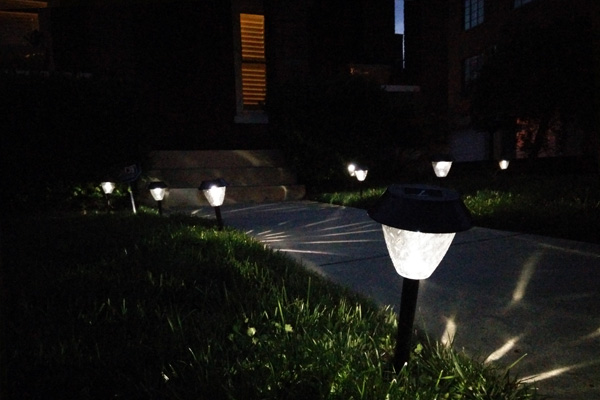 Image: Liz Foreman for HouseLogicWhen the sun goes down, don’t be left groping for your wine glass. Outdoor lighting dresses up your home’s marketability and appeal (exterior lighting is buyers’ most wanted outdoor feature, according to the NAHB study), makes it safer, and lets you spend more time outside.
Image: Liz Foreman for HouseLogicWhen the sun goes down, don’t be left groping for your wine glass. Outdoor lighting dresses up your home’s marketability and appeal (exterior lighting is buyers’ most wanted outdoor feature, according to the NAHB study), makes it safer, and lets you spend more time outside.
 Image: Liz Foreman for HouseLogicWhen the sun goes down, don’t be left groping for your wine glass. Outdoor lighting dresses up your home’s marketability and appeal (exterior lighting is buyers’ most wanted outdoor feature, according to the NAHB study), makes it safer, and lets you spend more time outside.
Image: Liz Foreman for HouseLogicWhen the sun goes down, don’t be left groping for your wine glass. Outdoor lighting dresses up your home’s marketability and appeal (exterior lighting is buyers’ most wanted outdoor feature, according to the NAHB study), makes it safer, and lets you spend more time outside.- Use uplighting to highlight trees, architectural details, or other focal points.
- Add sconces or pendant lights to make evening entertaining, grilling, and reading easier.
- Illuminate walkways, rails, and steps with landscape solar lights.
- Hang fairy or string lights to set an enchanting tone.
5. Make Your Mark
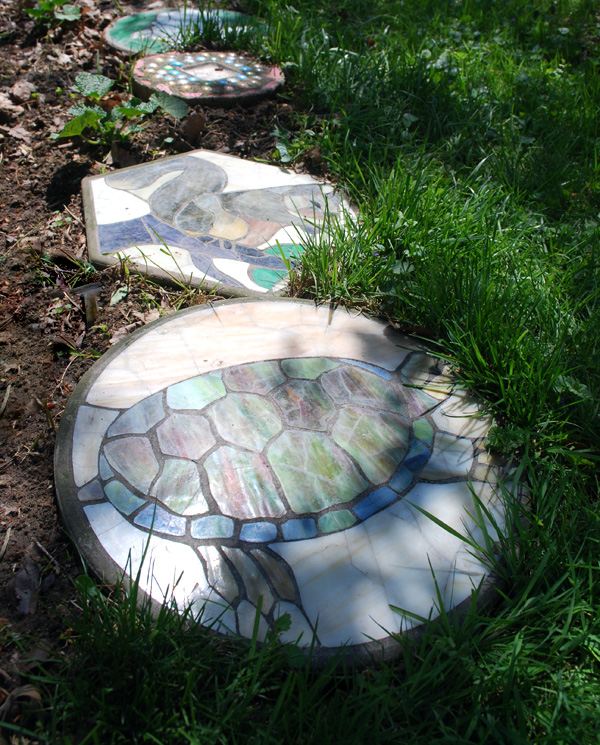 Image: Liz Foreman for HouseLogicLet your style dominate your backyard space.
Image: Liz Foreman for HouseLogicLet your style dominate your backyard space.
 Image: Liz Foreman for HouseLogicLet your style dominate your backyard space.
Image: Liz Foreman for HouseLogicLet your style dominate your backyard space.- Paint a faux rug with your favorite colors.
- Create a path made with colored glass, brick, or other interesting found materials.
- Craft a one-of-kind outdoor chandelier.
- Build a pizza oven, custom seating, or other feature you crave.
- Add personal décor that makes you happy.
In fact, make your outdoor retreat an ongoing project where you can hone your DIY skills.
6. Don’t Give Anyone an Excuse to Stay Inside
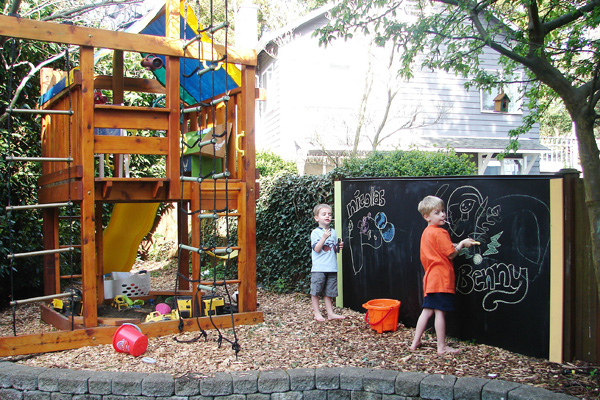 Image: Tasya Demers from My House and Home
Image: Tasya Demers from My House and Home
Your outdoor space will magnetically draw family and friends if it has features they find appealing.
6. Don’t Give Anyone an Excuse to Stay Inside
 Image: Tasya Demers from My House and Home
Image: Tasya Demers from My House and HomeYour outdoor space will magnetically draw family and friends if it has features they find appealing.
- A fire pit is a proven winner. Food and fire have brought humans together since the dawn of time.
- Give wee ones the gift of magical thinking with an outdoor playhouse.
- Add whimsy with a chalkboard fence that both kids and fun-loving adults will enjoy.
- Add a doggie window in your fence to entertain Spot. Installing a dog run may even boost your home’s value. FYI: It’s been said that pets are one of the top reasons why people buy houses.
Related: Outdoor Projects You Can Do with the Kids
7. Rebuff the Elements
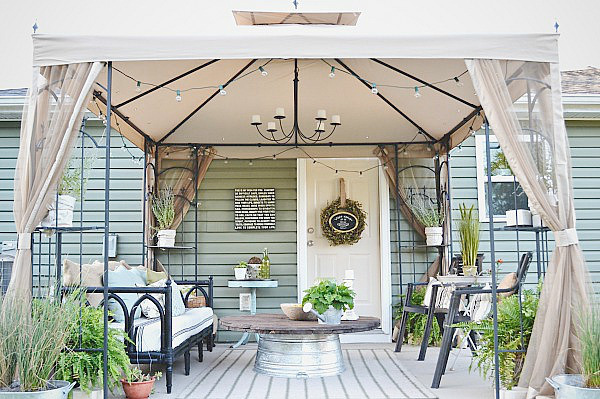
Image: LizMarieBlog.com
Hot sun, rain, wind gusts, and bugs are the archenemy of good times. Here are tips and strategies to help you throw shade on Mother Nature:
7. Rebuff the Elements

Image: LizMarieBlog.com
Hot sun, rain, wind gusts, and bugs are the archenemy of good times. Here are tips and strategies to help you throw shade on Mother Nature:
- Install an awning, canopy, or pergola. It’ll make it easier to read your Kindle or iPad and keep you dry during a summer shower. Look for products with polycarbonate panels, which block UV rays, too.
- Rig glass fence windscreens to the keep your BBQ fires burning.
- Screen in your porch or deck against bugs. But screening will be for naught if you forget the slats between wood planks. Cover the floor with outdoor carpet or staple screening to the underside of floorboards.
Read more: http://www.houselogic.com/home-advice/decks/outdoor-living-ideas/#ixzz3bSRU1afP
Follow us: @HouseLogic on Twitter | HouseLogic on Facebook
Wednesday, May 27, 2015
Saturday, May 23, 2015
Thursday, May 21, 2015
101 Things I Love about Portland Maine
Judith Clothing on an Old Port side street-- great clothes and unique designers!
Tuesday, May 19, 2015
101 Things I Love about Portland Maine
The Press Hotel is now open and a treat to visit just to see the creative decorating with newspaper theme.
Lounge bar is called the Inkwell!
Thursday, May 14, 2015
Get Rid of Weeds
7 Killer Ways to Get Rid of Weeds
- Published: March 14, 2012
- By: Lisa Kaplan Gordon
Here are 7 ways to murder weeds with household items. You’ll save money and show no mercy to your garden’s uninvited guests.
- Effort: Low 1 hr. (spread newspapaers)
- Investment: Low $1 (newspaper)
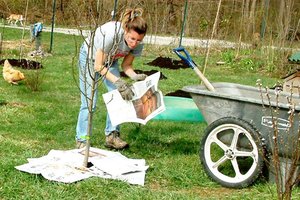 Layers of wet newspaper, buried under mulch, will smother weeds and prevent new ones from growing. Image: Jami Scholl/My Edible Eden
Layers of wet newspaper, buried under mulch, will smother weeds and prevent new ones from growing. Image: Jami Scholl/My Edible Eden
Nothing ruins your garden or yard like weeds, those uninvited guests that rob your plants of space and nutrients. So murder those weeds most foul, but without harmful chemicals that can do you in, too.
Who says you need standard weeding tools to kill weeds? Here are 7 ways to kill weeds with weapons you already have around your house.
How to Kill Weeds
Who says you need standard weeding tools to kill weeds? Here are 7 ways to kill weeds with weapons you already have around your house.
How to Kill Weeds
1. Newspaper: A carpet of newspaper, which blocks sunlight and oxygen from reaching the soil, will smother weeds already sprouted and prevent new ones from growing. Throw down newspaper in 10-sheet layers, wet to hold it down, and cover with an inch or two of mulch. If weeds begin to grow in the mulch, add more layers, making a mulch-newspaper lasagna, which eventually will decompose and nourish the soil.
2. Old shower curtains and carpet samples: Spreading these useless items in garden paths or between rows will keeps weeds from ever showing their unwanted heads. Cover with mulch.
3. Corn gluten meal: This corn by-product stops seeds from growing into weeds. Since the meal will prevent germination, spread it around established plants, and after seedlings and transplants have taken hold in the soil. After harvest, spread the meal to prevent late-season weeds.
4. Vinegar: The acetic acid in 5% vinegar is a desiccant that sucks the life out of plant leaves. It’s most destructive to young plants with immature roots, though it just rolls off weeds with waxy leaves, like pennywort or thistle.
Make sure you cover desirables before spraying, because vinegar is an equal opportunity killer. Keep your spray on-target by removing the bottom from a 2-liter plastic soda bottle, and placing it over the weed. Spray vinegar into the mouth of the bottle, which will keep it from splattering on your vegetables.
5. Vodka: Don’t know if vodka makes weeds fall down dead or drunk, but 1 ounce mixed with 2 cups of water and a couple of drops of dish soap will dry out weeds that live in the sun. Doesn’t work that well on shade-loving weeds. Protect desirables, because vodka will dry them out, too.
6. Soap: The oil in soap can break down waxy or hairy weed surfaces, making them vulnerable to desiccants. So add a few drops of liquid dish detergent to vinegar or vodka sprays to keep the solution on leaves. The soap also makes leaves shiny, which will help you keep track of what you’ve sprayed.
7. Boiling water: After you’ve made yourself a cup of tea, take the kettle outside and pour the boiling water on weeds, which will burn up. This is a particularly good way to whack driveway and walkway weeds, because the boiling water can run off impervious surfaces and cool before it reaches border plants.
More Tips to Eliminate Weeds:
2. Old shower curtains and carpet samples: Spreading these useless items in garden paths or between rows will keeps weeds from ever showing their unwanted heads. Cover with mulch.
3. Corn gluten meal: This corn by-product stops seeds from growing into weeds. Since the meal will prevent germination, spread it around established plants, and after seedlings and transplants have taken hold in the soil. After harvest, spread the meal to prevent late-season weeds.
4. Vinegar: The acetic acid in 5% vinegar is a desiccant that sucks the life out of plant leaves. It’s most destructive to young plants with immature roots, though it just rolls off weeds with waxy leaves, like pennywort or thistle.
Make sure you cover desirables before spraying, because vinegar is an equal opportunity killer. Keep your spray on-target by removing the bottom from a 2-liter plastic soda bottle, and placing it over the weed. Spray vinegar into the mouth of the bottle, which will keep it from splattering on your vegetables.
5. Vodka: Don’t know if vodka makes weeds fall down dead or drunk, but 1 ounce mixed with 2 cups of water and a couple of drops of dish soap will dry out weeds that live in the sun. Doesn’t work that well on shade-loving weeds. Protect desirables, because vodka will dry them out, too.
6. Soap: The oil in soap can break down waxy or hairy weed surfaces, making them vulnerable to desiccants. So add a few drops of liquid dish detergent to vinegar or vodka sprays to keep the solution on leaves. The soap also makes leaves shiny, which will help you keep track of what you’ve sprayed.
7. Boiling water: After you’ve made yourself a cup of tea, take the kettle outside and pour the boiling water on weeds, which will burn up. This is a particularly good way to whack driveway and walkway weeds, because the boiling water can run off impervious surfaces and cool before it reaches border plants.
More Tips to Eliminate Weeds:
 Lisa Kaplan Gordon is an avid gardener, a member of the Fairfax County Master Gardeners Association, and a builder of luxury homes in McLean, Va. She’s been a Homes editor for Gannett News Service and has reviewed home improvement products for AOL. Follow Lisa on Google+.
Lisa Kaplan Gordon is an avid gardener, a member of the Fairfax County Master Gardeners Association, and a builder of luxury homes in McLean, Va. She’s been a Homes editor for Gannett News Service and has reviewed home improvement products for AOL. Follow Lisa on Google+.Read more: http://www.houselogic.com/home-advice/landscaping-gardening/how-to-get-rid-of-weeds-naturally/#ixzz3a8QGSh6A
Follow us: @HouseLogic on Twitter | HouseLogic on Facebook
Saturday, May 9, 2015
7 Things You Should Paint Instead of Replace to Save Money
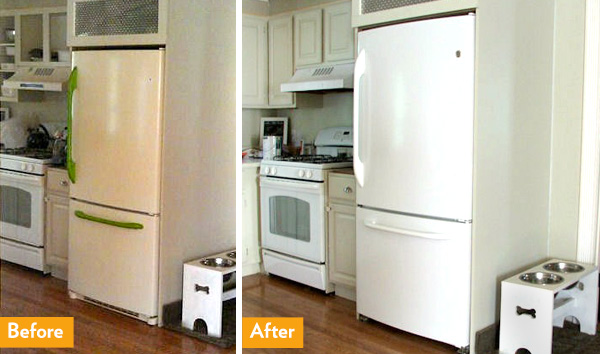 When her not-so-old fridge started looking yellow, blogger Dria decided to give appliance paint a try. She loves the result, which she says has the same glossy shine and feeling of the original factory finish. Image: DIO Home Improvements
When her not-so-old fridge started looking yellow, blogger Dria decided to give appliance paint a try. She loves the result, which she says has the same glossy shine and feeling of the original factory finish. Image: DIO Home Improvements
You know a fresh coat of paint can give any room a quick and inexpensive facelift. But did you know that a little paint can also perk up carpets, appliances, and even vinyl floors?
Basically, if it doesn’t move, you can paint it. But only after you’ve paid special attention to prep — cleaning, patching, and sanding (generally) the area.
Painting isn’t brain surgery, but it’s not a breeze, either. Here are some rules of thumb:
Painting isn’t brain surgery, but it’s not a breeze, either. Here are some rules of thumb:
- Prime before painting. Primer will allow the paint to adhere better.
- Most hard surfaces will take primer better if they’re roughed up a little with fine-grade sandpaper.
- When using spray paint, multiple, thin layers are better than one, thick coat. Ease up on your trigger finger, and spray in short bursts.
- Wait for the previous coat of paint or primer to dry completely before adding another coat.
1. Door, Drawer, and Cabinet Hardware
Spray paint can turn builder-grade brass locks and hinges into fashion-forward hardware with an oil-rubbed bronze, pewter, or stainless look.
Prep:
1. Clean hardware with a fine steel wool to remove grease and grime.
2. Rough up the surface with fine-grain sandpaper.
3. Before you paint, insert a tiny strip of painter’s tape into the keyhole to make sure paint doesn’t gunk it up.
4. Prime with a metallic primer, then paint with metallic spray paint.
Tip:
- Insert the door lock’s spindle into a square of Styrofoam, which will hold it upright while you spray around the knob.
2. Brick Fireplace
When you paint your red brick fireplace, you transform the entire room. But beware! Once you paint brick, it’s nearly impossible to return it to the original brick color.
You can paint brick a single color, or achieve some variation — like the variations in real brick — by sponging on slightly lighter and darker hues.
Prep:
1. Lightly sand away any loose bits of brick or mortar with 120-grit sandpaper.
2. Clean dirt and soot with a wire brush and heavy-duty cleanser.
3. Allow to dry completely before applying an oil-based, stain-blocking primer.
4. Paint with a semigloss latex.
Tips:
- Never paint the firebox.
- Brick is porous and drinks paint, so buy twice what you think you’ll need.
- Wear safety glasses and gloves when cleaning anything with a metal brush.
3. Ceramic Tile
Imagine how sweet it is to update ceramic tile without having to bust up and cart away tons of old tile.
Play it safe and avoid painting tiles in high-traffic and high-moisture areas. Some good places are laundry room floors, backsplashes under cabinets (but not above ranges where pasta sauce splatters), and walls around tubs you rarely use.
Prep:
1. Repair cracked or chipped tile with caulk or grout before painting.
2. Give patching material ample time to dry, then lightly sand before applying an epoxy or urethane bonding primer.
3. Sand after priming and between each coat of quality latex paint.
4. Wait several days for the paint to cure completely, then seal with two or three coats of clear, water-based polyurethane.
Tips:
- To get a smooth look, apply paint in zigzags, then roll down in one, smooth motion.
- Use 240-grit wet/dry sandpaper for prep and between coats.
- Don’t forget safety goggles and masks when sanding tiles.
4. Wood Floors
When wood floors are beyond another refinishing, painting can give them a second life — and give you a chance to add a personal touch to your home.
Prep:
1. Slightly sand the surface so your primer will adhere better. No need to sand down to the wood; even roughing up the seal coat will help the primer adhere better.
2. Vacuum and mop with a damp cloth to remove all the dust — nothing ruins a paint job faster than dust.
3. Tint your primer to reduce the number of coats you’ll need of latex enamel floor paint.
Tips:
- Before you commit to a paint color, paint a large piece of foam board with a sample of your desired color and put it on the floor to give you a good idea what the finished floor will look like.
- It takes each coat about 24 hours to dry completely. So don’t jump the gun when applying the next, thin coat.
- Your painted floor won’t completely cure for almost a month, so hold off on moving back heavy things like pianos and chests of drawers.
- Protect your painted floor by putting mats down at the sink (wood and paint hate water) and high-traffic entryways.
We love the idea of covering stains and reviving a carpet with upholstery paint. It saves hundreds of dollars and the hassle of getting rid of an old carpet.
Kathie Smula of Spray It New upholstery paint says carpets with a short pile are the best candidates for painting; long-pile carpets become hard and matted when painted.
Prep:
1. Thoroughly clean the carpet before painting. You don’t have to steam clean it, but scrub up the worst stains and vacuum so dust and dirt don’t mix with the paint.
2. Skip priming and just spray paint two or three coats, depending on how deep you want the color. Make sure it’s dry to the touch before spraying another coat.
Tips:
- Don’t confuse upholstery paint, good for carpets, with fabric paint, good for T-shirts.
- If you get heavy handed and paint clumps, loosen the area with a bristle brush and dab up excess paint.
- Six cans of spray paint will cover an 8-foot-by-10-foot carpet with at least two coats.
6. Vinyl Floors
Painting is an inexpensive way to get a few more years out of old vinyl floors in kitchens and laundry rooms.
Prep:
1. Wash the floor with a TSP (tri-sodium phosphate) solution to get rid of built-up dirt and grime.
2. Rough up the shiny surface with 180-grit sandpaper. If some nooks and crannies remain glossy, apply a deglosser (paint stores sell it) to remove shine.
3. Prime with a latex primer.
4. Paint with a porch/floor paint.
Tips:
- Save your back when sanding floors by using a sanding pole, like the ones drywall installers use.
- Highly textured vinyl floor may require another sanding and a second coat of primer.
7. Appliances
Heat-resistant appliance paint will perk up your kitchen. Use an indoor appliance paint to change colors, or a liquid stainless steel application to give your appliance the stainless steel look.
Use a roller for small touchups; two or three thin coats of spray paint is better for total appliance coverage.
Prep:
1. Clean appliance exteriors with a heavy-duty cleaning solution and, if needed, a scrubbing pad.
2. Remove handles and hardware; place painters tape over trim and logos.
3. Sand the exterior.
Tips:
- Make sure the front of your appliance is metal, not plastic. Plastic exteriors will require priming, while appliance paint will stick more easily to metal exteriors.
- If you’re spray-painting, haul the appliance outdoors to avoid getting paint on cabinets and floors. If you paint indoors, open windows to assure proper ventilation.
- For the stainless look, Liquid Stainless Steel is the go-to product. It’s got real flakes of stainless steel. Apply with a brush.
 Lisa Kaplan Gordon is an avid gardener, a member of the Fairfax County Master Gardeners Association, and a builder of luxury homes in McLean, Va. She’s been a Homes editor for Gannett News Service and has reviewed home improvement products for AOL. Follow Lisa on Google+.
Lisa Kaplan Gordon is an avid gardener, a member of the Fairfax County Master Gardeners Association, and a builder of luxury homes in McLean, Va. She’s been a Homes editor for Gannett News Service and has reviewed home improvement products for AOL. Follow Lisa on Google+.Read more: http://www.houselogic.com/home-advice/painting/painting-ideas-to-save-money/#ixzz3ZfaQYG8V
Follow us: @HouseLogic on Twitter | HouseLogic on Facebook
Friday, May 8, 2015
Thursday, May 7, 2015
101 Things I Love about Portland Maine
Happy Hour at Ebb and Flow: Cocktail of the day $5.50, delicious snacks like zucchini fritters, and nice wait staff.
Wednesday, May 6, 2015
Portland Maine April Real Estate Sales Stats
April
Single Family Stats for Maine 2015
Red = April 2014
|
Tuesday, May 5, 2015
Monday, May 4, 2015
Sunday, May 3, 2015
Subscribe to:
Posts (Atom)




























